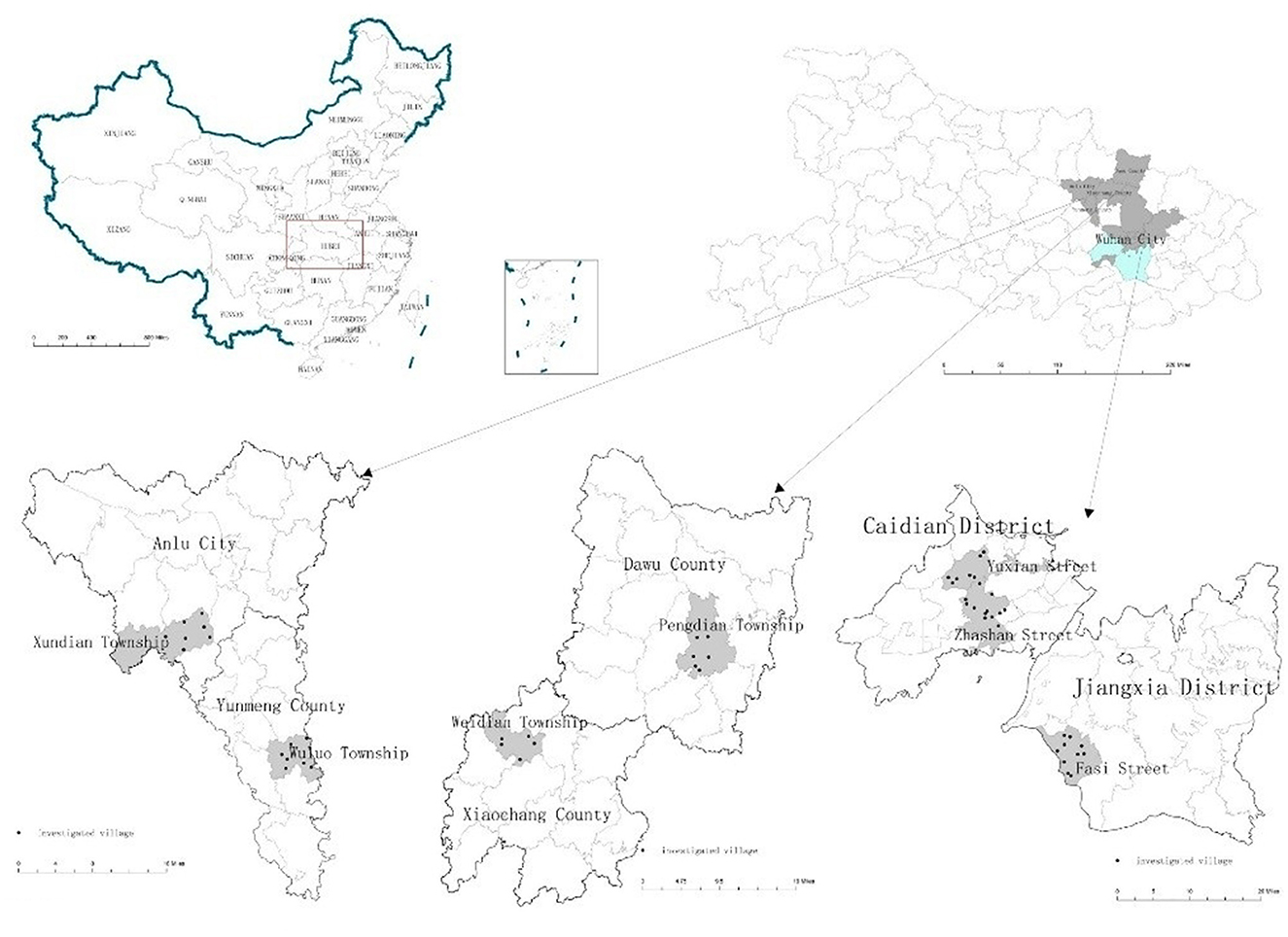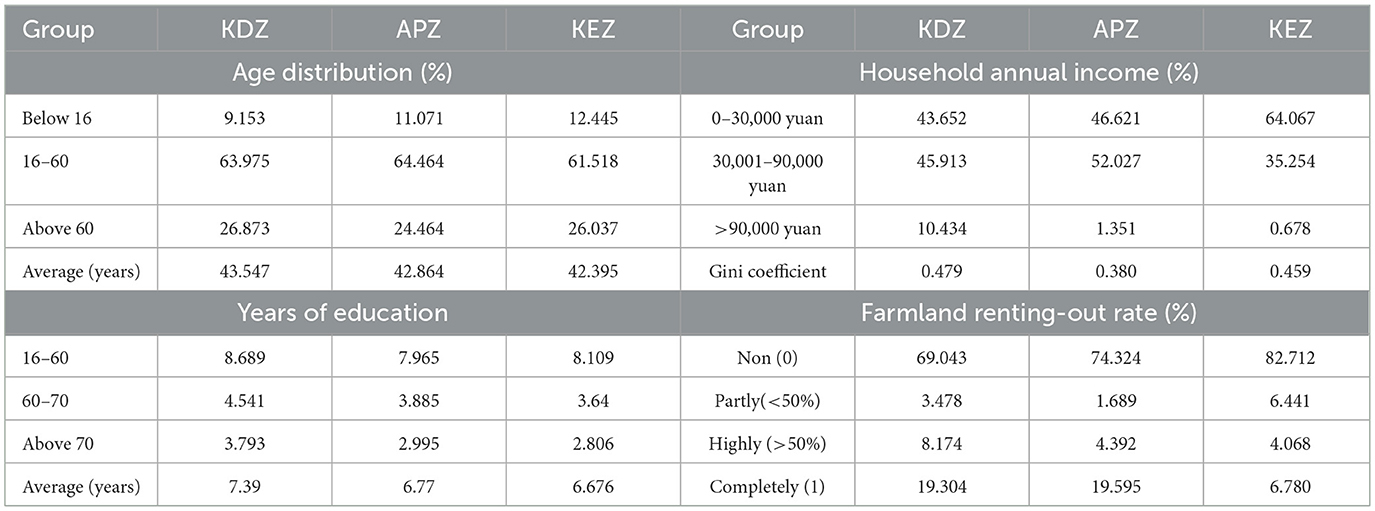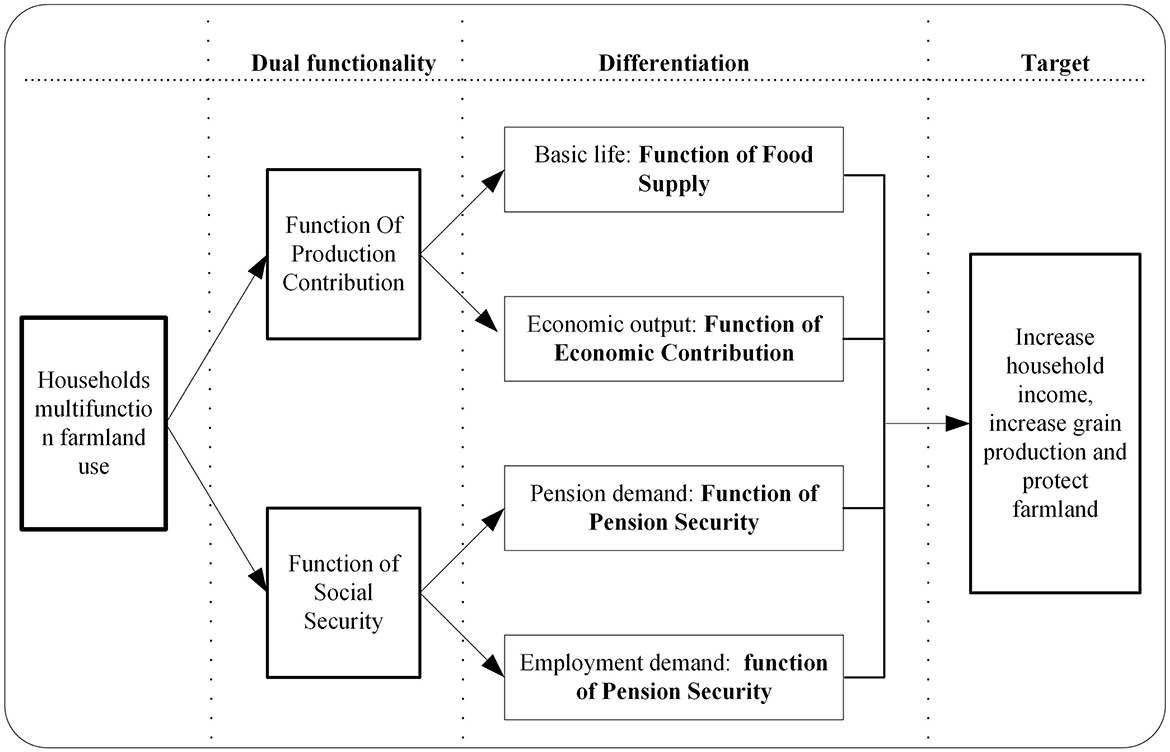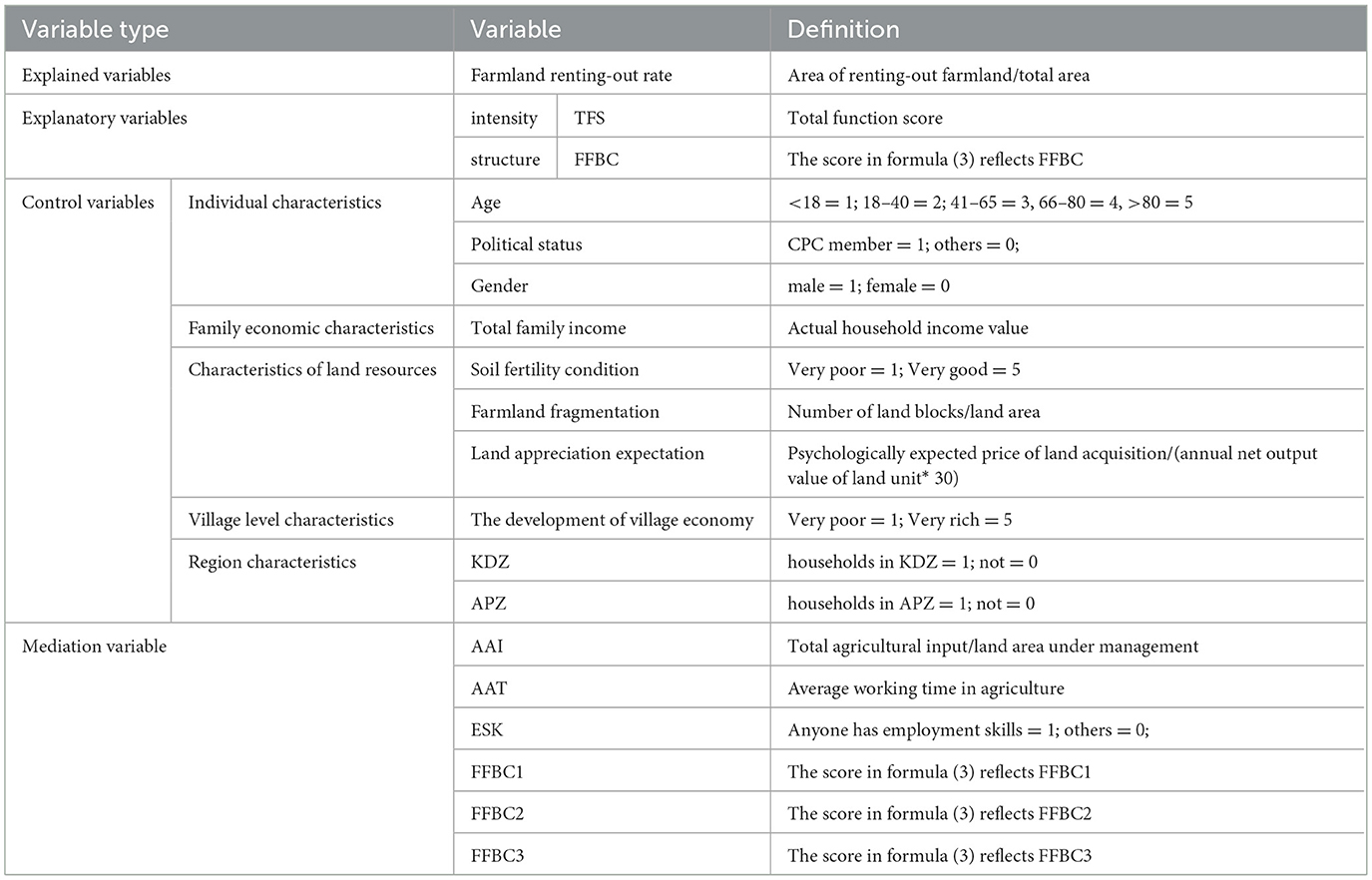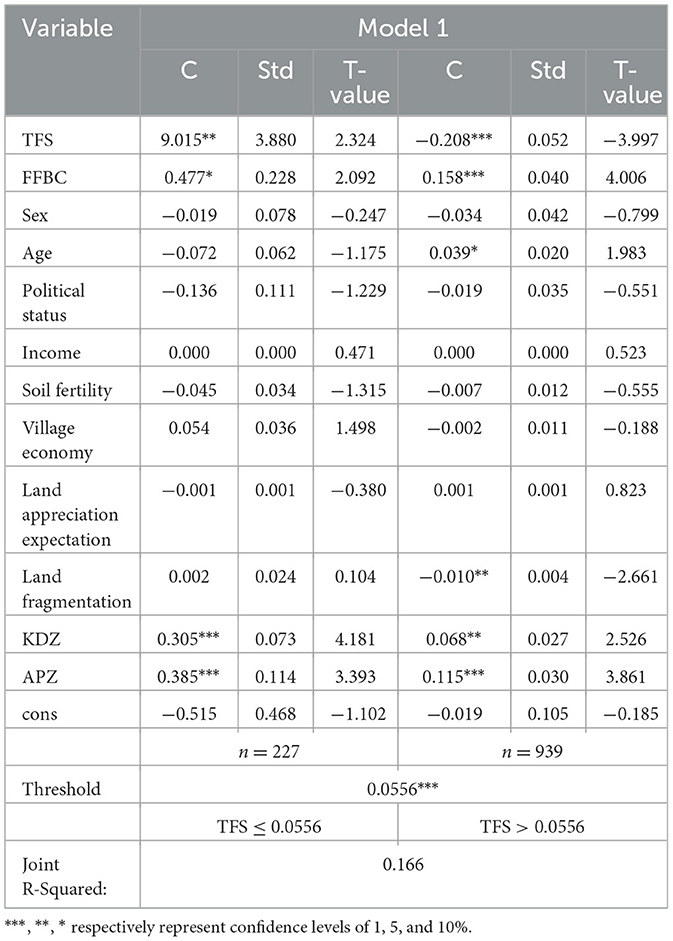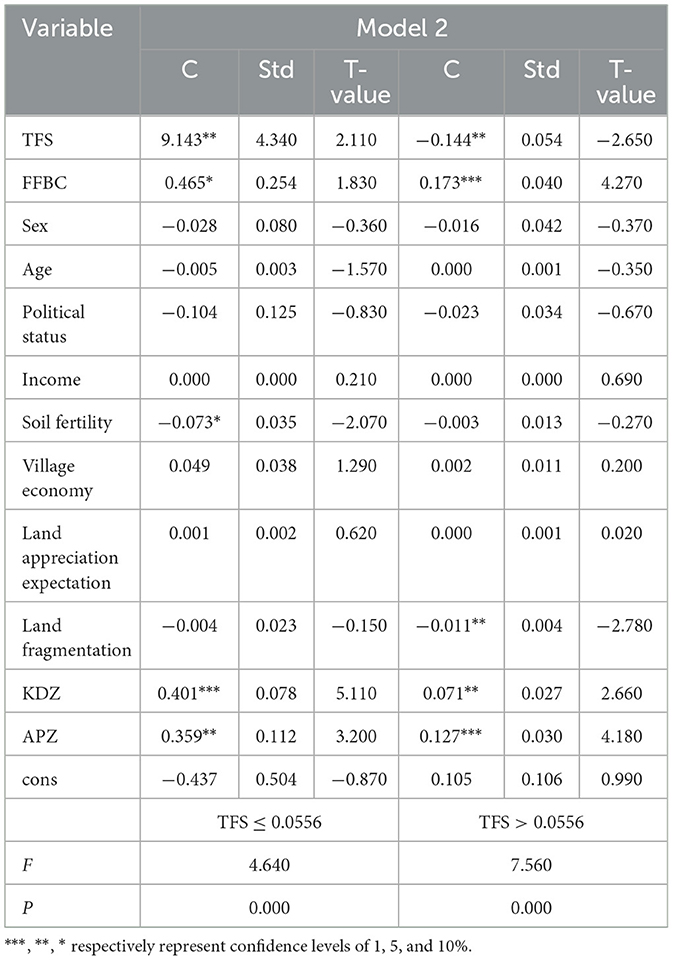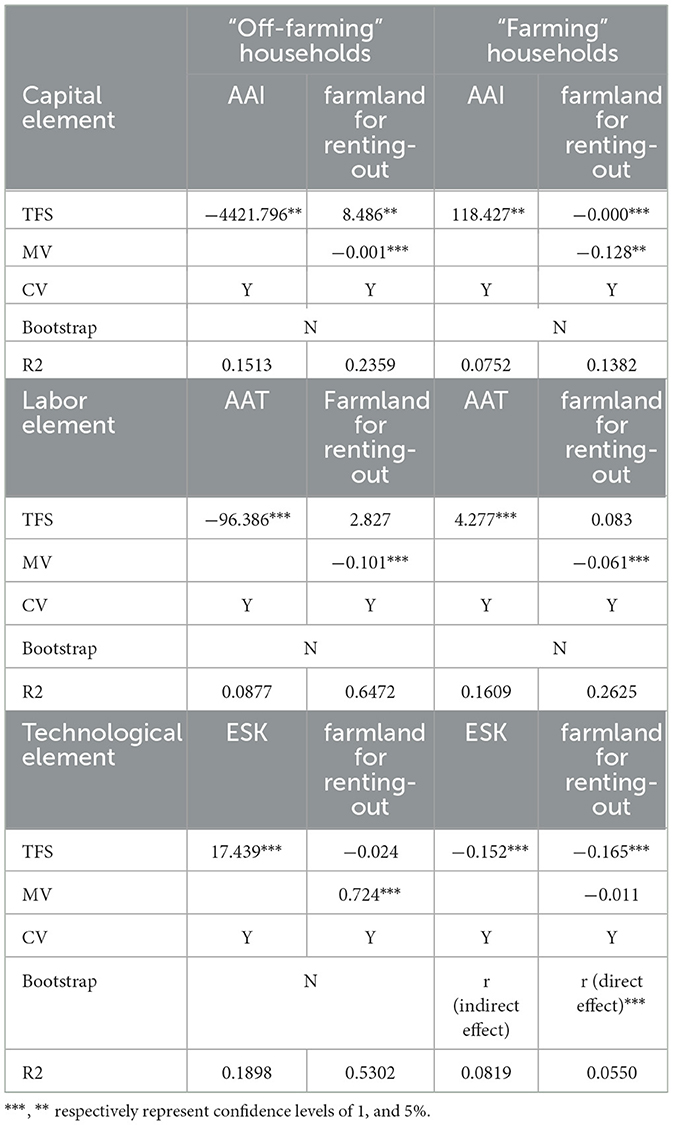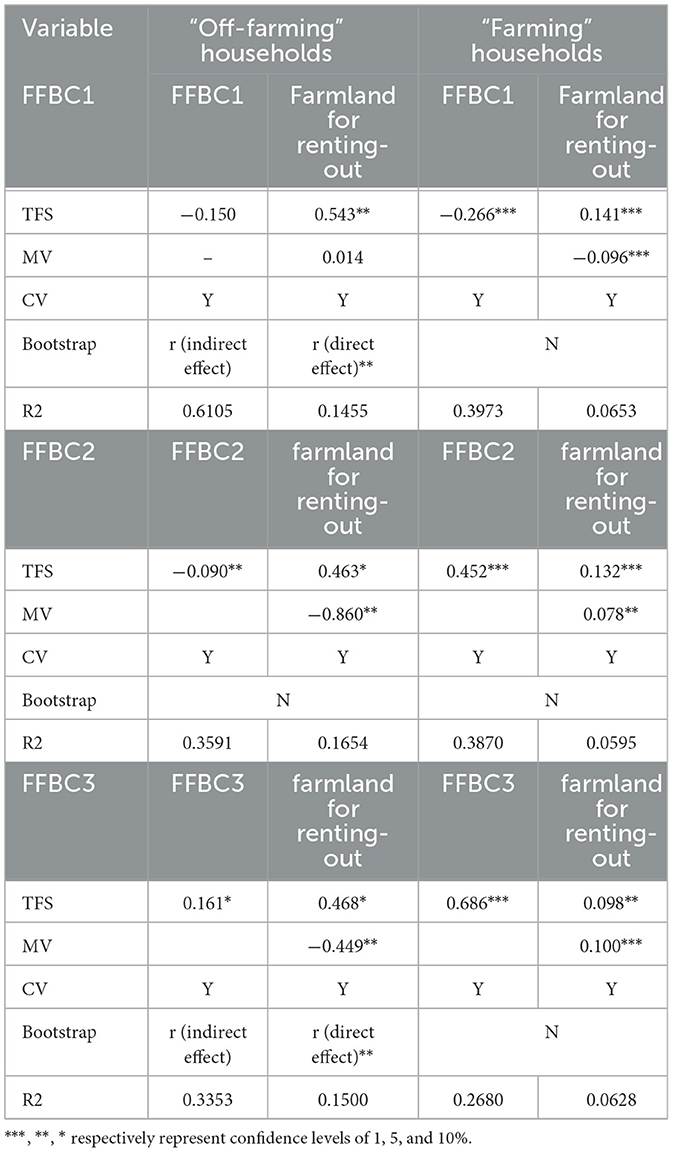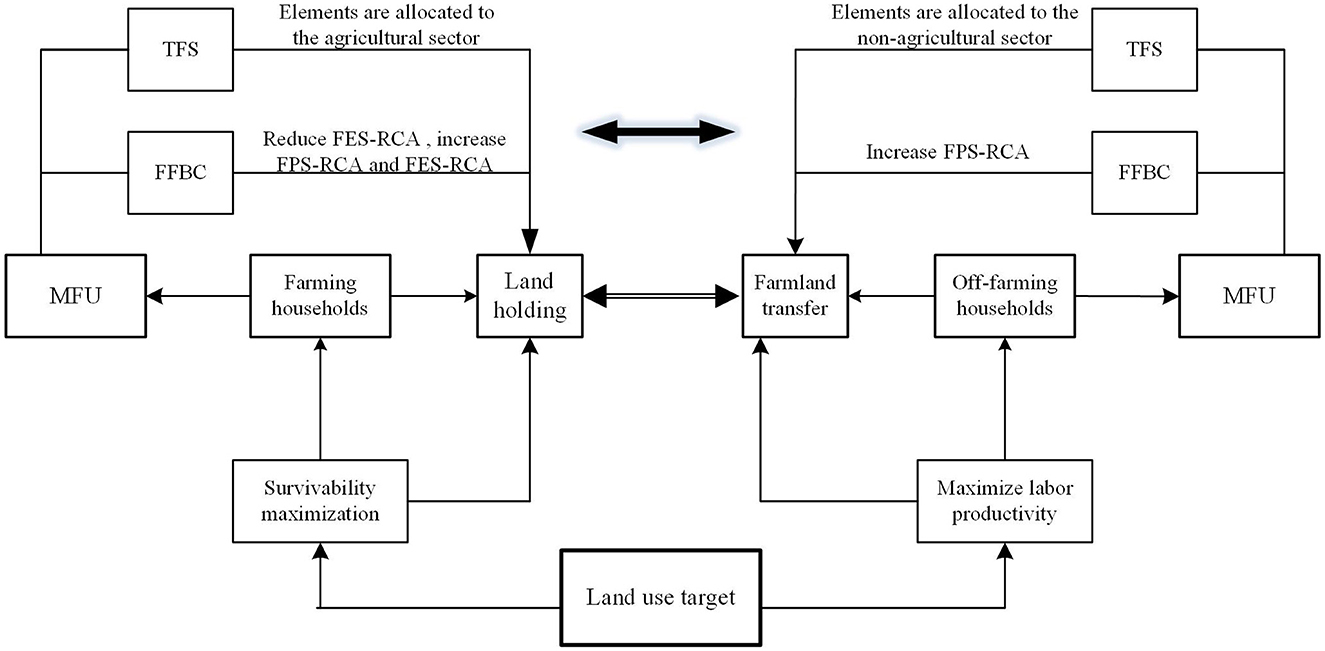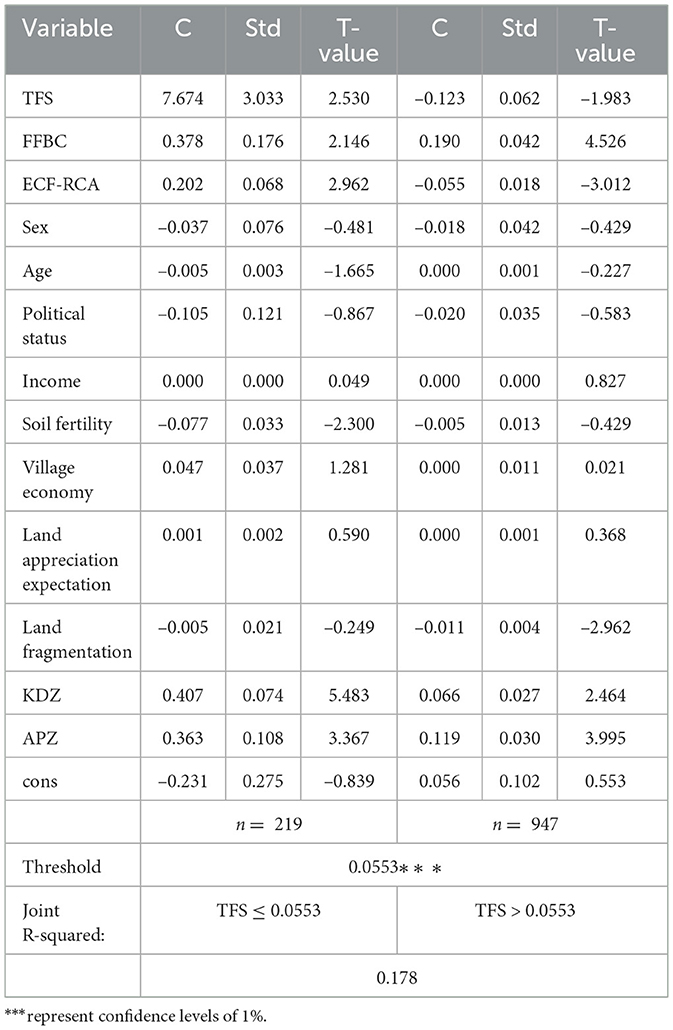- 1Collaborative Innovation Center for Emissions Trading System Co-constructed by the Province and Ministry, Hubei University of Economics, Wuhan, China
- 2School of Low Carbon Economics, Hubei University of Economics, Wuhan, China
- 3School of Public Administration, Huazhong Agriculture University, Wuhan, China
Farmland in aging societies increasingly serves dual roles as a productive asset and an intergenerational safety net, creating institutional path dependence that drives heterogeneous household responses to multifunctional farmland use (MFU). This study constructs Revealed Comparative Advantage (RCA) indices to quantify the structural balance of MFU across four functions: Economic Contribution (ECF), Food Supply (FSF), Pension Security (PSF), and Employment Security (ESF). A threshold regression model was employed to identify nonlinear effects of MFU on farmland renting-out, while mediation analysis elucidated underlying mechanisms. Key findings reveal: (1) An inverted U-shaped relationship between MFU intensity and farmland renting-out, with a tipping point at Total Functional Score (TFS) = 0.056. Higher intensity inhibits farmland renting-out for farming households (β = −0.208, p < 0.01) but promotes farmland renting-out for off-farming households (β = 9.015, p < 0.05); (2) Functional imbalances universally drive renting-out, exerting three-fold stronger effects on off-farming households (β = 0.477 vs. 0.158), where synergy between the economic contribution function (ECF) and pension security function (PSF) amplifies these imbalances while farming households resist farmland renting-out through employment security function (ESF)-PSF trade-offs. These effects are amplified by synergies between the ECF and PSF, while farming households counter farmland renting-out pressures through trade-offs between ESF and PSF. These results demonstrate how institutional-socioeconomic interactions (e.g., collective ownership and urban-rural welfare gaps) bifurcate land-use decisions. We advocate context-specific governance, such as "land- for-pension" schemes in Key Ecological Zones and ECF-optimized leasing in development zones to reconcile multifunctionality with sustainable transitions. This provides actionable pathways for agrarian economies navigating aging and urbanization globally, bridging land-use efficiency and intergenerational equity in pursuit of Sustainable Development Goals.
1 Introduction
The challenge of managing farmland's triple roles as a production base, economic engine, and social stabilizer (multifunctional farmland use (MFU) has become central to global rural transformation. From Europe's CAP regions to smallholder farms in Africa, aging societies and urban expansion are turning agricultural lands into dual-purpose assets: income-generating resources intertwined with retirement safety nets. This role conflict generates competing priorities between farmland retention and rental, creating fundamental tensions in achieving the Sustainable Development Goals (SDGs).
In 2020, the proportion of rural elderly (age ≥ 60) in China reached 23.81%, and these elderly households face a stark choice: retain farmland for elderly pension security or lease it out for higher non-agricultural income. Similar dilemmas are observed globally—for instance, in Eastern Europe's post-socialist economies (Ortyl et al., 2024) and Sub-Saharan Africa's smallholder systems (Abay et al., 2021), where structural imbalances in MFU (e.g., economic dominance over social functions) distort land-use decisions and hinder sustainable transitions. This is a hallmark of farmland rental markets in the Global South, where farmland acts as a crucial safety net due to underdeveloped credit and insurance systems (Kvartiuk and Petrick, 2021). Household farmland renting-out decisions are thus fundamentally shaped by the trade-off between their economic and security functions under uncertainty (Holden et al., 2010; Abay et al., 2021).
The core of this tension lies in the functional competition of MFU farmland, which serves both as a productive asset and a social safety net. While existing studies recognize MFU's role in balancing agricultural productivity and rural welfare (Li et al., 2025; de Groot et al., 2022), they largely overlook two critical dimensions: (1) Structural imbalances in MFU, such as the dominance of economic contribution functions (ECF) over social functions, including pension security function (PSF) and employment security function (ESF), which distort farmland renting-out decisions; and (2) threshold effects of MFU intensity, where dependency levels bifurcate household land use behaviors. Despite these divergences, policies adopt a homogenized approach, such as uniform subsidies in China or the EU's CAP, that fails to address structural imbalances. For instance, farmland renting-out incentives ignores farming households' PSF dependency, while agricultural stabilization measures neglect off-farming households' ESF-driven mobility (Zhu et al., 2025). This mismatch highlights the urgent need to quantify how MFU's functional hierarchy (e.g., ECF dominance vs. PSF-ESF synergy) and intensity thresholds govern farmland rental behavior—a gap this study aims to bridge through household level structural analysis.
This theory-policy disconnects practice stems partly from methodological limitations in existing studies. For instance, prior studies predominantly focus on isolated MFU functions, particularly ECF and ESF, while neglecting structural interdependencies. For example, Vranken and Swinnen (2006) demonstrated that households prioritizing economic contribution of farmland use exhibit lower renting-out willingness due to perceived profit losses, a finding corroborated by Zhang et al. (2025). from the perspective of China's new agricultural subsidy. Conversely, Huang et al. (2023) linked off-farm labor migration (ESF decline) to increased farmland renting-out, yet paradoxically observed stagnant rental-in markets. It is worth questioning why, amidst the continuous decline in the income and security functions of land and the increasing prevalence of non-agricultural employment, a significant number of farmers remain unwilling to rent out their farmland, even though the rental rate reached 38% in 2022. The inconsistency between this theoretical result and the actual situation underscores a critical limitation: prior works analyze MFU functions in silos, ignoring structural balance (e.g., ECF dominance vs. ESF-PSF synergy) and threshold effects (e.g., intensity tipping points). In recent studies, discussions on the functional structure of MFU have primarily been conducted at the regional scale, with a relative scarcity of research exploring the MFU at the household level. The limited studies rely on oversimplified indices (e.g., total MFU score) rather than comparative advantage coefficients (RCA) to capture functional imbalances (Li et al., 2016). A paradigm shift toward multidimensional MFU analysis, integrating intensity, structure, and dominant functions, is thus imperative to reconcile theoretical insights with sustainable land governance (Wang and Cai, 2017).
To bridge the theory-policy disconnect, this study decodes the dual mechanisms of MFU impacts, including intensity thresholds and structural imbalances, by quantifying their differential effects on renting-out behaviors through household level RCA coefficients and threshold regression. This approach offers a scalable model for regions undergoing agrarian transitions. For aging societies (e.g., Japan, Italy) or rapidly urbanizing economies (e.g., India, Nigeria), our findings challenge one-size-fits-all land policies and advocate for tailored strategies. This study first assessed the intensity and structure of the MFU. The heterogeneous effects were quantitatively identified using the threshold effect model with cross-sectional data. Moreover, the Mediation Effect Model was employed to reveal the transmission mechanisms of the impacts. The remainder of this paper is arranged as follows: Section 2 introduces the methodology, including the assessment of the MFU at the household level, model construction, and data preparation. Section 3 presents the empirical analysis and quantifies the impacts. Section 4 presents the discussion, and the main conclusions are drawn in Section 5.
2 Materials and methods
2.1 Study areas and data source
The data comes from the household survey with the theme of “household multifunctional farmland use” conducted by the research group in rural areas of Hubei Province in 2021. The study area is selected from the three Main Functional Zones determined by the “Main Function Zoning of Hubei Province” (MFZH). Due to funding constraints and the size of our research team, the survey series was tracked at the village level rather than continuously at the household level. Household level data include the characteristics of the household population, income, farmland renting-out, and land resources; village-level data include the characteristics of transportation, economy, and land use of the survey village.
The sampling survey was conducted according to the main functional zones divided by the MFZH. The MFZH divides 103 county-level administrative units in Hubei Province into Key Development Zones (KDZ), Agricultural Production Zones (APZ), Key Ecological functional Zones (KEZ), and Prohibited Development Zones (PDZ). Considering that Prohibited Development Zones (PDZs) were excluded from the sampling frame as they are primarily small, discrete areas (e.g., nature reserves, military zones) with severe restrictions on human activities and land use, making standard farmland renting-out behaviors largely inapplicable, our survey is only focused on KDZ, APZ, and KEZ. The sampling method is stratified sampling. One to two counties are selected for each main functional zone, and one to two townships are selected for each county; 30%−50% of villages are selected for each township according to the number of villages under its jurisdiction, and 10% of households are sampled for each village according to its size. Well-trained interviewers visited each selected household to carry out interviews using a standardized questionnaire. Eligible respondents were farmers who made decisions in their households. A total of 1,200 questionnaires were distributed in 55 villages (see Figure 1). After eliminating invalid questionnaires due to missing information and non-conformance with identity authentication, 1,166 questionnaires were adopted, with an effective rate of 97.17%.
Table 1 reports the basic characteristics of the sampled rural households. (1) The average age of household members in the study area is about 43.547 years old. The household labor in the survey area is relatively sufficient, with more than 60% of the population aged 16–60 years. However, the aging situation is evident, with the proportion of the elderly exceeding 24%. (2) The education level of the household members is low (7.39 years), and they generally only complete the primary education stage (3). The household income in the study area varies significantly. The household income of KDZ is relatively high, with 10.42% annual household income over 90,000 yuan, while the Gini coefficient is the largest (0.479); the household income level in APZ is low, while the Gini coefficient is relatively low (0.380); the household income level in KEZ is the lowest, with 64.07% household annual income below 30,000 yuan.
The farmland renting-out varies significantly across different MFZs. The farmland renting-out in KDZ is high, with a higher proportion of rural households that completely renting-out their farmland to others, which is 30.96% and 19.30%, respectively. In contrast, the farmland renting-out rate and the proportion of households that completely renting-out their farmland to others in KEZ are lower. Households in APZ exhibit a 74.3% farmland retention rate (vs. 30.96% in KDZ), driven by higher reliance on subsistence agriculture (The average value of FSF-RCA is 1.20).
2.2 Theoretical basis for MFU on farmland renting-out
2.2.1 Connotation of MFU
MFU in rural households is more prominent as a function of production and social security (Wang et al., 2020). The degree of ecological function of farmland use at the household level is relatively low, and it may be more important at a larger scale, such as the regional ecological security function. Therefore, MFU can be regarded as the capacity of rural households that use the farmland to provide production and social security services that directly or indirectly satisfy households' needs. This capability stems from the differences in land use demand among rural households.
It should be noted that, with the changes in the external environment of agriculture brought about by industrialization and urbanization, there may be differentiation in the production and social security functions of MFU. For example, the production functions of farmland use may be divided into production functions that focus on food security and those that focus on economic contribution. Therefore, the dual functionality of MFU in production and social security can be further refined.
As shown in Figure 2, first, the food supply function is the basic function of MFU, which is a broad consensus by relevant research (Jiang et al., 2020; Allan et al., 2015; Gómez-Limón et al., 2012). Second, farmland cooperates with other production factors, such as labor and capital, to provide the ECF (Maniruzzaman et al., 2024). Third, in the process of rapid urbanization and industrialization, the aging of the agricultural labor force is a common feature in rural areas, and their livelihoods are highly dependent on farmland use; the PSF of farmland use is gradually strengthened (Guo and Wang, 2024). Fourth, on the one hand, the ability of the female labor force to work in the non-agricultural sector is relatively low; the rural left behind female labor force has employment demand for farmland use (Dabara and Chiwuzie, 2022); on the other hand, the possibility of male labor force returning to their hometown to work in agriculture when they are getting old (Liu et al., 2022) Retaining farmland resources for their own or future generations' use, meeting basic employment, and avoiding social risks is a long-term tradition of rural households. Therefore, the ESF of farmland use is becoming increasingly prominent.
2.2.2 A household typology based on livelihood strategies
The classification of rural households into “farming” and “off-farming” categories is rooted in their different livelihood strategies, which are shaped by the trade-offs between “survival maximization” and “efficiency maximization.” Households pursuing “survival maximization” prioritize securing basic needs through MFU (e.g., PSF and ESF), often retaining farmland as a social safety net against income volatility and aging risks. In contrast, households oriented toward “efficiency maximization” allocate resources (e.g., labor, capital) to optimize returns across sectors, leading to higher farmland rental rates when non-agricultural opportunities are dominant (Otsuka, 2013). This typology is operationalized through two key dimensions: (1) “agricultural dependency” (proxied by TFS scores) and (2) “opportunity cost of farmland retention” (reflected in off-farm income share). Holden et al. (2010) further validate this framework by demonstrating that households with limited non-agricultural options exhibit stronger adherence to survival-driven land use, while those with diversified income streams align with efficiency-driven behaviors.
2.2.3 Theoretical framework of heterogeneous responses to MFU on farmland renting-out
The rental of rural surplus labor to non-agricultural sectors has brought about tremendous changes in the livelihoods of rural households compared with traditional approaches, e.g., from “living on agriculture” to “part-time production” (Kuang et al., 2020). The coexistence of agriculture and non-agriculture is a common feature in rural areas. Limited by labor force, ideology, and other reasons, the probability of some households (farming households) opting for non-agricultural employment is relatively low, resulting in a lower total household income and a greater reliance on land use and agricultural production for their livelihoods. Thus, when aiming to maximize survival, they are more inclined to reserve farmland for agricultural production. For other households (off-farming households), the marginal income of the non-agricultural sector is far larger than that of the agricultural sector. The opportunity cost of farmland renting-out is almost zero. Off-farming households tend to choose to withdraw from farming land and are more inclined to renting-out their farmland to maximize benefits. This differentiation caused by the intensity of MFU leads to an inverted U-shaped relationship between MFU and farmland renting-out (Figure 3A).

Figure 3. (A) Heterogeneous response of MFU intensity to farmland renting-out. (B) Heterogeneous impacts of MFU structural imbalance on farmland renting-out.
The structure of MFU reflects the differences in the intensity of single-function use and the combination of multiple functions among rural households. Generally, the more balanced the structure of MFU, the more evenly different farmland functions are used in rural households, and the lower the renting-out of their farmland. However, the effect of MFU structure on farmland renting-out behavior differs across household types. Off-farming households have higher labor productivity and earn more from non-farm jobs. For them, a greater imbalance in MFU encourages leaving agriculture and promotes the renting-out of farmland. In contrast, farming households rely heavily on agricultural income. They are more sensitive to changes in farmland productivity and value. Their decisions respond more strongly to these factors, which appear in the model as a steeper slope. These households prefer to keep farmland for farming. They reduce MFU imbalance to avoid renting out their farmland. These household types are characterized by their differential dependency on agricultural income and off-farm opportunities, operationalized via the TFS threshold. Therefore, this difference in the orientation of farmland use will also lead to the heterogeneous responses of MFU's structure on household renting-out behavior (Figure 3B).
2.3 MFU assessment method
2.3.1 Constructing the index system of MFU
According to the analysis in Section 2.2.1, the MFU is divided into the ECF, FSF, PSF, and ESF. The definition of farmland functions and the selection of evaluation indicators are shown in Table 2:
• The ECF is defined as the function of the economic benefits brought to the rural households by farmland use. The index of net income status of farmland management reflects the contribution of farmland resources to household income. The index of per capita farmland income of labor reflects the economic income level of farmland use.
• The FSF is defined as the ability of farmland use to produce agricultural products that meet the basic needs of rural households. The index of the level of the grain self-sufficiency rate and the level of the vegetable self-sufficiency rate reflects the ability of farmland to produce agricultural products to meet the daily consumption demand of rural households.
• The PSF highlights the significance of farmland use for elderly members in rural households. The index of the proportion of family pension expenditure in total income reflects the relative pressure of total pension insurance expenditure on household economic expenditure; the index of the proportion of elderly peasants reflects the agricultural activity situation of the elders, which is aimed at measuring the ability for elder security.
• The ESF reflects the employment demand of farmland use for the household labor force. Considering that the young and middle-aged labor force may need to return to their hometowns for farming when they get older, they have potential demand for ESF. Meanwhile, the female labor force has more employment requirements for farmland use than the male labor force, such that the index of the proportion of female labor and the proportion of returning farmers in the future are selected.
2.3.2 Calculation method for MFU
The assessment of MFU has been performed using different methods (Fan et al., 2023; Castillo-Eguskitza et al., 2018). Due to the obvious differentiation of MFU at the household scale, the studies analyze and measure MFU at the rural household level. The multiplicity and complexity of MFU necessitate empirical research that is characterized by complexity, objectivity, and scientific rigor. The entropy method, which avoids the subjective assignment of index weight, is commonly used to obtain objective weights (Smith, 1974). Because there are no strict requirements for the sample size and distribution of households, the method is suitable for evaluating MFU at the household level. The specific calculation formula and steps of the entropy weight method are omitted for conciseness.
2.4 Model construction of MFU on farmland for renting-out
2.4.1 Construction of the threshold effect model for cross-sectional data
The threshold effect refers to the phenomenon that when an economic parameter reaches a specific value, another economic parameter suddenly turns to other forms of development. The specific value that causes the phenomenon is called the threshold value, and the threshold value is endogenous after model regression, which is more objective than the result of subjective selection. The study constructs a threshold model to document the impact of MFU on farmland renting-out using the Total Farmland Function Score (TFS) as the threshold variable.
Given the irreversibility of household livelihood transitions in rural China (e.g., off-farming households rarely return to agriculture), cross-sectional threshold models (Hansen, 2000) are better suited than panel approaches to capture MFU tipping points. We selected TFS as the threshold variable because it holistically represents households' functional dependency on farmland, a dependency that theoretically bifurcates renting-out decisions when exceeding critical levels. The basic formula is given as follows:
In Equation 1, xi is the key explanatory variable; q is the threshold variable; γ is the threshold value; βi1 and βi2 are the influence coefficients of the explanatory variable when threshold variables are at qi ≤ γ and qi >γ, respectively. In fact, the model is equivalent to a piecewise function model; when q ≤ γ, the coefficient of xi is βi1; when qi >γ, the coefficient of xi is βi2.
According to the threshold regression theory proposed by Hansen, if the threshold value is given as γ in the threshold model, the estimated values of the coefficients in the model can be calculated to obtain the sum of the residual squares of the model. Moreover, the closer the threshold value given in the model is to the true threshold level, the smaller the sum of squares of the residuals of the regression model will be. Therefore, the threshold value of the model can be given continuously. By observing the change in the residual error of the model, the threshold value of the sum of squares of the residual error is minimized. The real threshold we require is the optimal threshold. After this threshold value is determined, the threshold model performs a significance test on the estimated parameters of two groups of samples divided by the threshold value.
2.4.2 Variables selected and their calculation
1. Explained variables: The variable of farmland renting-out refers to the proportion of farmland renting-out to the total farmland area of rural households (see in Table 3). It must be emphasized that farmland is the most important type of land use in rural China, which has a more general significance for the agricultural production and other utilization of rural households, and there are fewer samples of the other types of land (forest land, pasture land, pond, etc.). Therefore, this study only analyzes the farmland renting-out in rural households and does not include other land types.
2. Explanatory variables: The explanatory variables are selected to reflect the structure and intensity characteristics of MFU in the rural household, which is mainly divided into two categories.
The first category reflects the intensity of MFU. MFU in the study is mainly divided into ECF, FSF, PSF, and ESF (shown in Section 2.3.1). Then, we calculate the Total Function Score (TFS) by calculating the four farmland use functions into a total value with the entropy weight method.
The second category reflects the structure of MFU. The Farmland Function Balance Coefficient (FFBC) reflects the structural balance of MFU. The specific calculation steps are as follows:
In Equation 2, Function-RCAik represents the Relative Comparative Advantage Coefficient of the k-type farmland use function in rural households. The Function-RCA can be determined using the index of RCA, which is used to measure and determine the international market competitiveness of industries. This adaptation is justified because RCA effectively captures the relative intensity of a household's dependence on each multifunctional dimension, regardless of its market nature. For instance, a PSF-RCA > 1 indicates that the household relies more heavily on its farmland for old-age support compared to the average household in the study area, which is a meaningful measure of non-market functional dependency. This effectively captures the relative intensity of a household's dependence on each multifunctional dimension, regardless of its market nature. The larger the value, the greater the RCA of the farmland use function. Fik represents the k-th farmland use function score of the i-th rural household; Fak represents the score of the k-th farmland use function in the study area.
In Equation 3, FFBC reflects the structural balance of MFU. The higher the index value is, the more unbalanced the MFUs are sdi refers to the standard deviation of the i-th household's Function-RCA, and Mean refers to the average value of the Function-RCA.
3. Control variables: The farmland renting-out is not only influenced by the MFU, but also by the characteristics of rural households, villages, and so on. Therefore, we set up control variables such as individual characteristics, economic characteristics, farmland resources characteristics, village level characteristics, and regional variables.
• Individual characteristics. The individual characteristics of rural households mainly include the age, gender, and political status of the rural household head.
• Economic characteristics. These mainly choose the total family income to reflect the economic characteristics of rural households.
• Village level characteristics. The level of village economic development is introduced to control the possible impact of village level characteristics on farmland renting-out.
• Farmland resources characteristics. The characteristics of farmland resources primarily affect the households' farmland renting-out by affecting agricultural production and planting, selecting soil fertility, farmland fragmentation, and land appreciation expectation to reflect the characteristics of arable land resources.
• Regional variable: Considering that regional differences may also lead to different farmland renting-out, we choose KDZ (Key Development Zones) and APZ (Agriculture Production Zones) as two regional dummy variables to reflect regional differences. The basis for regional division is shown in Section 2.1.
4. Mediator variable: We further selected mediator variables to explore the impact mechanism of MFU on farmland renting-out at the household level.
• Mediator variable of TFS. We selected production factor indicators (Excluding land factors, because farmland renting-out reflects the allocation of land factor) as the mediator variables of TFS. The variables of Average Agricultural Input per mu (AAI) reflect the capital factor; the variables of Average Agricultural working Time of households (AAT) reflect the labor factor; the variables of whether the households have Employment Skills (ESK) reflect technical factors.
• Mediator variable of FFBC. Because ECF plays a more important role in MFU (as shown in Section 2.2.1 and 3.3), we calculate the dispersion between the RCA of other farmland use functions and ECF-RCA, and use it as a mediator variable. This mainly includes the variables of the farmland function balance coefficient between ECF-RCA and FSF-RCA (FFBC1), the farmland function balance coefficient between ECF-RCA and PSF-RCA (FFBC2), and the farmland function balance coefficient between ECF-RCA and ESF-RCA (FFBC3).
3 Results
Guided by the dual-threshold framework, our analysis proceeds in three stages: (1) identifying MFU intensity tipping points, (2) quantifying structural imbalance (FFBC) effects, and (3) unraveling ECF-dominated transmission mechanisms. Each stage directly addresses the research questions posited in Section 1.
3.1 Impacts of MFU intensity on farmland renting-out
First, we tested the impacts of MFU intensity on the farmland renting-out in Model 1 using the cross-sectional data threshold effect model. Table 4 shows that the original hypothesis is rejected at the 1% significance level when the variable TFS is taken as the threshold variable, indicating that the intensity of MFU exhibits threshold-driven bifurcation in renting-out decisions, and the threshold value is 0.056. Given the considerable importance of ECF in rural household farmland use (mean value = 0.269), we reintroduced the ECF-RCA metric into the model for recalibration. The results show a TFS threshold value of 0.055, which is nearly identical to the previously observed value of 0.056, confirming the robustness of the findings. Detailed results are provided in Appendix A.
The estimation results in Table 4 show that when the TFS score is less than 0.056, i.e., with a low dependence on farmland use, rural households are separated from agricultural production (we name rural households with this feature “off-farming” households). TFS has a positive impact on farmland renting-out with a coefficient of 9.015, passing the significance test under 5%, which shows that the higher the MFU of rural households, the larger the scale of farmland renting-out. When the TFS in rural households is greater than 0.056, i.e., rural households that still maintain a certain farmland scale for agricultural production (we name the households with this feature “farming” households), the TFS has a negative impact on the farmland renting-out, with a coefficient of −0.208. Significance at the 1% level indicates that the higher MFU in “farming” households is associated with the smaller scale of farmland renting-out. In contrast, the coefficient of TFS in “off-farming” households is significantly higher than that of the “farming” households, and MFU intensity triggers threshold-modulated behavioral bifurcation on farmland renting-out. These household types are characterized by their differential dependency on multifunction farmland use, operationalized through the TFS threshold.
In a sense, the threshold effect is a grouping regression; hence, we choose the value of the threshold variable as the grouping variable to regress different samples. Compared with Model 1, the significance and direction of the main explanatory variables (TFS) in the Group regression model have not changed significantly, which indicates that the results of Model 1 are robust. The results are shown in Table 5.
3.2 Impacts of MFU structure on farmland renting-out
The variable FFBC, which reflects the structural balance of MFU, yields different results. On both sides of the threshold variable (TFS) value, the coefficient of FFBC has a positive impact on the farmland renting-out, with the coefficients of 0.477 and 0.158 passing the significance test at the 10% and 1% levels, respectively. This indicates that whether for farming households or off-farming households, the more unbalanced the MFU is, the more it can promote the rural household to rent out their farmland to others. In contrast, the coefficient of FFBC on farmland renting-out in off-farming households is about three times that of farming households. This further shows that off-farming households are more sensitive to the structural change of MFU when they rent out their farmland. Thus, the impact of MFU structure on farmland renting-out is not consistent among different rural households. We still carry out the robustness test by grouping regression and substitution variables. Relevant results are reported in Table 5, and the main explanatory variable (FFBC) of Model 1 is robust.
4 Discussion
Three pivotal findings emerge from our analysis: the threshold effect at TFS = 0.056, the structural leverage of FFBC, and ECF-PSF synergy as a transmission linchpin. These results challenge conventional wisdom in three key aspects, which we contextualize against prior studies below.
4.1 Comparisons with previous studies
The key point of the research on farmland renting-out is to analyze the restrictive factors and their impact mechanism. To date, most studies on the impact mechanism of households' farmland renting-out have been conducted from the perspectives of property rights stability, financial awareness, transaction costs, and so on (Kong et al., 2018; Tan et al., 2022; Kan, 2021). In turn, there are relatively few studies on the comprehensive analysis of the impact of MFU on farmland renting-out, mainly focusing on the single function use and average impact on farmland renting-out (Kung, 2002; Feng et al., 2010; Huang et al., 2023; Xu et al., 2018; Su et al., 2018; Deng et al., 2018; Zhou et al., 2020).
In the complex “nature–economy–society” interaction, the MFU at the household level reflects the capacity of rural households to utilize farmland to meet the demand of household agriculture production and social security, which forms a consensus in the research but lacks quantitative measures. Studies have shown that during the process of urbanization, MFUs have undergone a transformation (Zhang et al., 2021), resulting in the differentiation of rural households and further affecting the farmland renting-out. Compared with previous studies, methodologically, this study pioneers the application of Revealed Comparative Advantage (RCA) coefficients to quantify MFU structural dynamics, overcoming the oversimplification of aggregated scores in prior literature (e.g., Li et al., 2023). Theoretically, we propose a “structure-threshold” dual-axis framework, integrating non-linear intensity effects and functional trade-offs, which advances land system science beyond conventional “one-size-fits-all” paradigms (e.g., Kung, 2002). By bridging multifunctionality theory with farmland rental market dynamics, this research offers a scalable model for addressing agrarian transitions in aging and urbanizing contexts globally.
4.2 Threshold-tradeoff driven heterogeneity of MFU on farmland renting-out
The threshold tradeoff framework reveals that the intensity of MFU has a heterogeneous effect on the farmland renting-out between farming households and off-farming households. However, the impact mechanism of MFU on farmland renting-out is not very clear, which may result in missing out on more information. Based on the above information, we discuss the impact mechanism of the heterogeneous responses of MFU on household renting-out behavior by using the mesomeric effect test. The dual-threshold framework reveals that the mechanisms through which MFU influences farmland renting-out bifurcate along both intensity (TFS) and structural (FFBC) axes, mediated by heterogeneous factor allocations and functional trade-offs.
4.2.1 Threshold-driven pathways: economic reallocation vs. survival lock-in
For off-farming households (TFS ≤ 0.056), reduced agricultural dependency triggers capital and labor reallocation. A 1-unit decrease in agricultural input (AAI: β = −4,421.8, p < 0.05) correlates with a 2.5% rise in renting-out rates (Table 6), exemplified by off-farming households achieving a 30% income boost through e-commerce training (ESK: β = 17.439), a strategy aligning with China's urbanization drive but constrained by the hukou system's welfare exclusion. Despite 280 million rural migrants working in cities, most retain contracted land as a “safety net” due to exclusion from urban social welfare. This institutional barrier explains why households resist renting out all their farmland—farmland remains a critical PSF asset even in the face of declining agricultural returns (ECF). Conversely, farming households (TFS > 0.056) resist renting out by intensifying agricultural inputs (AAI: β =118.427), prioritizing food self-sufficiency (FSF-RCA = 1.20) as a buffer against market risks, a behavior reinforced by the 2018 Rural Land Contract Law, which prohibits land sales. This aligns with the state's “food security first” policy, where subsistence farming buffers against market risks, even at the cost of lower income, a trade-off embedded in China's socialist land governance legacy.
4.2.2 Structural imbalances: ECF dominance and institutional amplifiers
The structure of MFU between rural households likewise differs significantly. Based on the four farmland use functions selected in this study, combined with the key role of the ECF-RCA in the results, we selected the variation coefficient of the other three Function-RCA combined with ECF-RCA to analyze the transmission mechanism of FFBC on farmland renting-out.
Based on the result in Table 7, the dominance of ECF over PSF/ESF amplifies renting-out incentives. A 1-unit increase in FFBC2 (ECF-PSF imbalance) raises renting-out by 0.86% (p < 0.01) for off-farming households, reflecting weakened pension security attachment (Table 6). In contrast, farming households mitigate rental by balancing ECF with ESF (FFBC3: β = −0.061, p < 0.01), as land remains critical for future labor reabsorption (e.g., 64% of KEZ elderly retain land for retirement). The dominance of ECF over PSF/ESF is not merely an economic phenomenon but a cultural-institutional hybrid. In KDZ villages, households with ECF-RCA >2.0 showed 88% higher renting-out rates than those with balanced MFU. In China's rural patrilineal society, land is intergenerational patrimony, with 73% of elderly farmers viewing it as a “family heritage” (Wang et al., 2020). This explains why PSF dependency persists despite urbanization: renting out farmland risks severing familial ties to ancestral property.
The magnitude of this trade-off is quantified by our finding that 49.40% of households exhibit a PSF-RCA greater than 1 concurrently with an ECF-RCA less than 1. For these households, farmland's value as a safety net (Wang et al., 2020) outweighs its immediate economic productivity, making it extremely difficult to decide to rent out their farmland and consequently risk losing that security for uncertain monetary gain. This is supported by empirical evidence across transitioning economies, where imperfect credit and insurance markets force households to prioritize risk minimization over profit maximization (Deininger et al., 2014).
4.2.3 Theoretical integration: policy-path dependence and path-creation
China's top-down land governance amplifies these mechanisms. The Household Responsibility System entrenched smallholder farming, while the “Three Rights Separation “reform commodified use rights without addressing collective ownership's social functions. This duality creates institutional ambivalence: farmers rent out their farmland for short-term ECF gains (e.g., to agribusiness) while retaining PSF/ESF for long-term security. Zhejiang's “land ticket” pilot reduced PSF dependency by 18% through urban-rural welfare linkage. Yet, such innovations remain fragmented, underscoring the need for integrated policies that strike a balance between market efficiency and social equity.
These findings demonstrate the explanatory power of our “structure-threshold” framework while underscoring China's distinctive institutional context. Unlike the EU's Common Agricultural Policy (CAP), which deliberately separates subsidy allocations from production outputs, China's MFU patterns are shaped by the interplay of collective ownership and persistent urban-rural welfare gaps. Our identified TFS threshold of 0.056 serves as a critical diagnostic tool, distinguishing between households' institutional attachment and contrasting land-dependent farmers with their non-farming counterparts. Simultaneously, the observed FFBC structural disparities expose how policy mechanisms differentially prioritize land functions.
4.3 Global insights: contrasting China's MFU dynamics with the EU's CAP
The differentiation of MFU is the result of the rural households' responses to external environmental changes based on their own differences, such as household endowment, land use target, and livelihood style. Specifically, different rural households will allocate production factors differently to pursue different land-use targets and meet the varying needs of household development. Therefore, it is necessary to pay more attention to the threshold-modulated heterogeneity impact of MFU on farmland renting-out caused by factor allocation, function structure difference, land use target, etc. (Figure 4).
The threshold-modulated heterogeneous behaviors on farmland renting-out in China share “similar objectives” with the EU's CAP, such as balancing agricultural productivity (ECF) and social security functions (PSF/ESF). However, their “policy instruments diverge fundamentally.” Under CAP's “green direct payments,” farmers receive subsidies conditional on ecological practices (e.g., maintaining ≥5% Ecological Focus Areas), which indirectly stabilize farmland retention by enhancing “ECF-PSF synergy.” Diversified land use boosts economic returns, while subsidized income reduces reliance on land-based pensions. In contrast, China's MFU-driven policies lack ecological conditionality, focusing instead on “household level functional rebalancing” (e.g., optimizing FFBC by reducing ECF dominance in KDZ zones). A key distinction lies in “PSF dependency.” In the EU, decoupled subsidies weaken farmland's role as a pension safety, though the implementation of ecological focus areas has faced challenges, particularly in newer member states of Eastern Europe (Milczarek-Andrzejewska et al., 2018; Ortyl et al., 2024), whereas in China, PSF remains critical (β = −0.096***), with 63% of elderly farmers retaining land for pension security. This contrast underscores the need for “region-specific designs.” CAP's market-oriented tools suit economies with mature welfare systems, while China requires “institutional hybrids” like “land-for-pension” pilots (current coverage 15%) to alleviate PSF-driven retention. Conversely, China's ongoing “Three Rights Separation” reform presents an opportunity to integrate ecological conditionality into its farmland rental markets. For instance, local governments could develop “green leasing” guidelines that offer incentives (e.g., streamlined transaction processes, modest tax benefits) to lessees who agree to maintain a certain percentage of rented land for ecological purposes (e.g., planting cover crops, maintaining hedgerows), thereby aligning market-driven rental with broader sustainability goals.
Our comparative analysis yields complementary policy insights for both regions. European policymakers could adopt China's structure-threshold approach to enhance CAP subsidy targeting, particularly in addressing vulnerable smallholders in regions such as Eastern Europe, where subsistence farming persists. Conversely, Chinese authorities might adopt EU-style ecological conditionalities, such as reserving ≥5% of leased farmland for biodiversity buffers, to better align farmland rental markets with sustainability targets. This cross-pollination of approaches—combining China's granular heterogeneity analysis with Europe's ecological governance frameworks—demonstrates how context-specific solutions can balance competing priorities. For China, this means reconciling the realities of collective ownership with market efficiency through technology-enhanced leasing systems. For the EU, it involves tailoring decoupled subsidies to localized sustainability indicators. Crucially, our findings challenge universal policy prescriptions, advocating adaptive hybrid models that translate multifunctional theory into actionable blueprints, particularly relevant for aging societies navigating urbanization challenges.
4.4 Uncertainties, limitations, and future research directions
From a more general perspective, our research is a preliminary step toward a better understanding of MFU and farmland rental markets, as there are still numerous areas of investigation to be conducted. Other studies, examining different functions through various assessments in other countries, would allow us to confirm or refute our conclusions, which, given the field studied here, are very specific. In addition, when building the indicator system of MFU, insufficient consideration is inevitably given to the selection of functional types, the establishment of indicator weights, the basis for division, and the impact mechanism. Notably, the aging of the agricultural labor force is a common problem facing the global agricultural restructuring. At present, the young and middle-aged rural labor force in China chooses to work in non-agriculture sectors, and the age of the rural population left behind for the agricultural labor force is relatively high. Although the farmland renting-out decisions made by the interviewed elderly households are relatively cautious, they remain rational decisions based on the labor situation and economic demand.
While our study identifies a critical tipping point at TFS = 0.056, this specific value is likely sensitive to the regional socio-economic context of Hubei Province. Although the exact threshold value (TFS = 0.056) may vary across regions with different land tenure systems, urbanization levels, or social welfare structures, such as in Japan or Italy, the existence of a non-linear threshold effect and its role in bifurcating household behavior is a generalizable theoretical insight. However, the core theoretical contribution that such non-linear thresholds exist and bifurcate household behavior is generalizable. Future cross-regional studies are recommended to calibrate this threshold for localized policy applications. However, the core theoretical contribution that such non-linear thresholds exist and bifurcate household behavior is generalizable. Future research should validate this framework by applying it to diverse contexts and conducting sensitivity analyses to establish the robustness and transferability of the threshold values.
Results show that the impact of regional variables (KDZ and APZ) on farmland renting-out passed the significance test. The three types of MFZs are determined according to the division of county-level administrative units in the MFZH. Compared with KDZ and APZ, KEZ has a lower farmland renting-out scale. Our household survey also found that most of the KEZs are hilly and mountainous areas, and it is difficult for rural households to return to their hometown for the farming season, which also results in a relatively large proportion of elderly farmers in the region. However, our analysis did not separate the three MFZs, which is another direction that follow-up research can take.
While these insights advance MFU theory, their translational potential hinges on spatially grounded policy design; the concluding section synthesizes these implications for agrarian transition in rural areas.
5 Conclusions and policy implications
5.1 Conclusions
This study reveals a non-linear threshold effect in the relationship between MFU intensity and farmland renting-out decisions, with a critical tipping point at TFS = 0.056. For off-farming households, higher MFU intensity beyond this threshold significantly promotes renting-out (β = 9.015, p < 0.05), while farming households exhibit the opposite trend (β = −0.208, p < 0.01), reflecting threshold-modulated heterogeneity dependency on farmland functions. Structural imbalance (FFBC) exerts a threefold stronger leverage on renting-out among off-farming households (β = 0.477 vs. 0.158 for farming households), underscoring the dominance of the ECF in driving market participation. Mechanistically, synergy between ECF and PSF amplifies structural imbalance, indirectly increasing renting-out by 35% (p < 0.01) for off-farming households, whereas farming households prioritize balancing ESF and PSF to resist rental pressures. These findings challenge homogenized land policies and underscore the need for household-type-specific interventions.
5.2 Policy implications
Building on the threshold-driven heterogeneity (TFS = 0.056) and structural imbalances (FFBC) identified in Hubei Province, policy interventions must align with China's rural institutional framework while integrating global insights. Combined with the fact that the growth rate of China's rural farmland rental market has slowed down, which means that simply pursuing farmland renting-out to promote large-scale operation is not an effective approach to achieve the sustainable goal in rural China, as it induces a heterogeneous effect rather than a linear relationship. Thus, different rural households have different farmland rental orientations. In view of promoting the threshold-modulated heterogeneity impact of MFU on farmland renting-out, we propose the following suggestions. The relevant policy suggestions can be adapted to countries and regions that have undergone dramatic transformation and differentiation of rural economic relations in response to the impact of the external environment.
For farming households (TFS > 0.056), localized measures like “Agricultural Resilience Packages”—combining subsidized agrotech inputs (e.g., 40% discounts on hybrid seeds) and village-level “Land Consolidation Cooperatives”—can mitigate fragmentation and stabilize agricultural dependency, particularly in APZs where farmland retention rates exceed 70%. Concurrently, off-farming households (TFS ≤ 0.056) should be incentivized through “Rural-Urban Skills Bridging Programs” (e.g., state-recognized certifications in logistics or e-commerce) and a “National Farmland Rental Platform” under the Ministry of Agriculture, leveraging blockchain to reduce transaction costs and enhance contract transparency, as observed in Zhejiang's pilot reforms.? While these proposals hold promise, their implementation may face challenges, including fiscal constraints, local governance capacity, and regional disparities in infrastructure. Pilot programs should therefore be phased in with robust monitoring and adaptive management frameworks in place to ensure effective implementation.
To address structural imbalances (FFBC), China's land-use policies could adopt “Ecological-Functional Zoning,” requiring 3%−5% of rental farmland in KDZs to support agroecological practices (e.g., organic buffers or pollinator habitats), paired with “Green Subsidy Tiers” (e.g., +15% compensation for eco-compliant farmland renting-out). Simultaneously, “Pension-Land Linkage Pilots” expanding the 2023 “land-for-social-security” trials should allow elderly farmers in KEZs to convert 30% of contracted land into state-guaranteed annuities, reducing PSF dependency while aligning with the study's finding that 63% of aging households resist farmland renting-out for pension security. These strategies balance global paradigms (e.g., EU-style ecological conditionality) with China's unique socialist rural governance, ensuring scalability across diverse MFZs while addressing the core tension between ECF dominance and PSF-driven land retention.
Data availability statement
The original contributions presented in the study are included in the article/supplementary material, further inquiries can be directed to the corresponding author.
Author contributions
YW: Conceptualization, Data curation, Formal analysis, Funding acquisition, Investigation, Methodology, Project administration, Resources, Software, Supervision, Visualization, Writing – original draft, Writing – review & editing. YC: Conceptualization, Data curation, Funding acquisition, Investigation, Writing – original draft.
Funding
The author(s) declare that financial support was received for the research and/or publication of this article. This research was funded by Ministry of Education of China Humanities and Social Sciences Research General Project (No. 20YJC630149), the National Natural Science Foundation of China (No. 72374080), and the Hubei Social Science Fund Post-Award Support Program (No. HBSK2022YB361).
Conflict of interest
The authors declare that the research was conducted in the absence of any commercial or financial relationships that could be construed as a potential conflict of interest.
Generative AI statement
The author(s) declare that no Gen AI was used in the creation of this manuscript.
Any alternative text (alt text) provided alongside figures in this article has been generated by Frontiers with the support of artificial intelligence and reasonable efforts have been made to ensure accuracy, including review by the authors wherever possible. If you identify any issues, please contact us.
Publisher's note
All claims expressed in this article are solely those of the authors and do not necessarily represent those of their affiliated organizations, or those of the publisher, the editors and the reviewers. Any product that may be evaluated in this article, or claim that may be made by its manufacturer, is not guaranteed or endorsed by the publisher.
References
Abay, K. A., Chamberlin, J., and Berhane, G. (2021). Are land rental markets responding to rising population pressures and land scarcity in sub-Saharan Africa?. Land Use Policy 101:105139. doi: 10.1016/j.landusepol.2020.105139
Allan, E., Manning, P., Alt, F., Binkenstein, J., Blaser, S., Blüthgen, N., et al. (2015). Land use intensification alters ecosystem multifunctionality via loss of biodiversity and changes to functional composition. Ecol. Lett. 18, 834–843. doi: 10.1111/ele.12469
Castillo-Eguskitza, N., Martín-López, B., and Onaindia, M. (2018). A comprehensive assessment of ecosystem services: integrating supply, demand and interest in the Urdaibai Biosphere Reserve. Ecol. Indic. 93, 1176–1189. doi: 10.1016/j.ecolind.2018.06.004
Dabara, D. I., and Chiwuzie, A. (2022). Female-Led agrarian households and the question of sustainable land and food security in an emerging economy: evidence from Tula Baule. Habitat. Int. 120:102512. doi: 10.1016/j.habitatint.2022.102512
de Groot, R., Moolenaar, S., de Vente, J., De Leijster, V., Ramos, M. E., Robles, et al. (2022). Framework for integrated Ecosystem Services assessment of the costs and benefits of large scale landscape restoration illustrated with a case study in Mediterranean Spain. Ecosyst. Serv. 53:101383. doi: 10.1016/j.ecoser.2021.101383
Deininger, K., Jin, S., Xia, F., and Huang, J. (2014). Moving off the farm: land institutions to facilitate structural transformation and agricultural productivity growth in China. World Dev. 59, 505–520. doi: 10.1016/j.worlddev.2013.10.009
Deng, X., Xu, D., Qi, Y., and Zeng, M. (2018). Labor off-farm employment and cropland abandonment in rural China: spatial distribution and empirical analysis. Int. J. Environ. Res. Public Health. 15:1808. doi: 10.3390/ijerph15091808
Fan, Y., Jin, X., Gan, L., Yang, Q., Wang, L., Lyu, L., et al. (2023). Exploring an integrated framework for “dynamic-mechanism-clustering” of multiple cultivated land functions in the Yangtze River Delta region. Appl. Geogr. 159:103061. doi: 10.1016/j.apgeog.2023.103061
Feng, S., Heerink, N., and Ruben, R. (2010). Land rental market, off-farm employment and agricultural production in Southeast China: a plot-level case study. Chin. Econ. Rev. 21, 598–606. doi: 10.1016/j.chieco.2010.06.002
Gómez-Limón, J. A., Vera-Toscano, E., and Rico-González, M. (2012). Measuring individual preferences for rural multifunctionality: the importance of demographic and residential heterogeneity. J. Agr. Econ. 63, 1–24. doi: 10.1111/j.1477-9552.2011.00325.x
Guo, Y., and Wang, J. (2024). Practices for rural population aging in China: land-based pension. Habit. Int. 151:103136. doi: 10.1016/j.habitatint.2024.103136
Hansen, B. E. (2000). Sample splitting and threshold estimation. Econometrica 68, 575–603. doi: 10.1111/1468-0262.00124
Holden, S. T., Otsuka, K., and Place, F. M. (2010). The Emergence of Land Markets in Africa: Impacts on Poverty, Equity and Efficiency. Washington, DC: Resources for the Future Press.
Huang, K., Cao, S., Qing, C., Xu, D., and Liu, S. (2023). Does labour migration necessarily promote farmers' land transfer-in?—empirical evidence from China's rural panel data. J. Rural Stud. 97, 534–549. doi: 10.1016/j.jrurstud.2022.12.027
Jiang, G., Wang, M., Qu, Y., Zhou, D., and Ma, W. (2020). Towards cultivated land multifunction assessment in China: applying the “influencing factors-functions-products-demands” integrated framework. Land Use Policy 99:104982. doi: 10.1016/j.landusepol.2020.104982
Kan, K. (2021). Creating land markets for rural revitalization: land transfer, property rights and gentrification in China. J. Rural Stud. 81, 68–77. doi: 10.1016/j.jrurstud.2020.08.006
Kong, X., Liu, Y., Jiang, P., Tian, Y., and Zou, Y. (2018). A novel framework for rural homestead land transfer under collective ownership in China. Land Use Policy 78, 138–146. doi: 10.1016/j.landusepol.2018.06.046
Kuang, F., Jin, J., He, R., Ning, J., and Wan, X. (2020). Farmers' livelihood risks, livelihood assets and adaptation strategies in Rugao City, China. J. Environ. Manage. 264:110463. doi: 10.1016/j.jenvman.2020.110463
Kung, J. K. (2002). Off-farm labor markets and the emergence of land rental markets in rural China. J. Comp. Econ. 30, 395–414. doi: 10.1006/jcec.2002.1780
Kvartiuk, V., and Petrick, M. (2021). Liberal land reform in Kazakhstan? The effect on land rental and credit markets. World Dev. 138:105285. doi: 10.1016/j.worlddev.2020.105285
Li, K., Zhao, J., Li, Y., and Lin, Y. (2025). Identifying trade-offs and synergies among land use functions using an XGBoost-SHAP model: a case study of Kunming, China. Ecol. Indic. 172:113330. doi: 10.1016/j.ecolind.2025.113330
Li, S., Shao, Y., Hong, M., Zhu, C., Dong, B., Li, Y., et al. (2023). Impact mechanisms of urbanization processes on supply-demand matches of cultivated land multifunction in rapid urbanization areas. Habitat. Int. 131:102726. doi: 10.1016/j.habitatint.2022.102726
Li, H., Cai, Y., and Wang, Y. (2016). Spatial heterogeneity and individual differences of arable land use functions in peasant household: a case study of representative area in Hubei Province. J. Nat. Resour. 31, 228–240. (In Chinese). doi: 10.11849/zrzyxb.20141640
Liu, M., Zheng, W., and Zhong, T. (2022). Impact of migrant and returning farmer professionalization on food production diversity. J. Rural. Stud. 94, 23–36. doi: 10.1016/j.jrurstud.2022.05.020
Maniruzzaman, M., Sarangi, S. K., Mainuddin, M., Biswas, J. C., Bell, R. W., Hossain, M. B., et al. (2024). A novel system for boosting land productivity and income of smallholder farmers by intercropping vegetables in waterlogged paddy fields in the coastal zone of the Ganges Delta. Land Use Policy 139:107066. doi: 10.1016/j.landusepol.2024.107066
Milczarek-Andrzejewska, D., Zawalińska, K., and Czarnecki, A. (2018). Land-use conflicts and the common agricultural policy: evidence from Poland. Land Use Policy 73, 423–433. doi: 10.1016/j.landusepol.2018.02.016
Ortyl, B., Kasprzyk, I., and Jadczyszyn, J. (2024). Trends and drivers of land abandonment in Poland under Common Agricultural Policy. Land Use Policy 147:107353. doi: 10.1016/j.landusepol.2024.107353
Otsuka, K. (2013). Food insecurity, income inequality, and the changing comparative advantage in world agriculture. Agric. Econ. 44, 7–18. doi: 10.1111/agec.12046
Smith, S. A. (1974). A derivation of entropy and the maximum entropy criterion in the context of decision problems. IEEE Trans. Syst. Man Cybern. 1974, 157–163. doi: 10.1109/TSMC.1974.5409109
Su, B., Li, Y., Li, L., and Wang, Y. (2018). How does nonfarm employment stability influence farmers' farmland transfer decisions? Implications for China's land use policy. Land Use Policy 74, 66–72. doi: 10.1016/j.landusepol.2017.09.053
Tan, J., Cai, D., Han, K., and Zhou, K. (2022). Understanding peasant household's land transfer decision-making: a perspective of financial literacy. Land Use Policy 119:106189. doi: 10.1016/j.landusepol.2022.106189
Vranken, L., and Swinnen, J. (2006). Land rental markets in transition: theory and evidence from Hungary. World. Dev. 34, 481–500. doi: 10.1016/j.worlddev.2005.07.017
Wang, Y., and Cai, Y. (2017). Relationship between cultivated land use functions and land rental behavior of rural households: empirical evidence from different dominant functional regions in central China. Chin. J. Popul. Resour. Environ. 15, 1–11. doi: 10.1080/10042857.2017.1365454
Wang, Y., Li, X., He, H., Xin, L., and Tan, M. (2020). How reliable are cultivated land assets as social security for Chinese farmers?. Land Use Policy 90:104318. doi: 10.1016/j.landusepol.2019.104318
Xu, D. D., Cao, S., Wang, X. X., and Liu, S. Q. (2018). Influences of labor migration on rural household land transfer: a case study of Sichuan Province, China. J. Mt. Sci. 15, 2055–2067. doi: 10.1007/s11629-018-4973-7
Zhang, Z., Peng, J., Xu, Z., Wang, X., and Meersmans, J. (2021). Ecosystem services supply and demand response to urbanization: a case study of the Pearl River Delta, Chin. Ecosyst. Serv. 49:101274. doi: 10.1016/j.ecoser.2021.101274
Zhang, J., Mishra, A. K., and Zheng, L. (2025). China's new agricultural subsidy and land rental market development: the dual perspective of efficiency and equity. Chin. Econ. Rev. 92:102420. doi: 10.1016/j.chieco.2025.102420
Zhou, X., Ma, W., Renwick, A., and Li, G. (2020). Off-farm work decisions of farm couples and land transfer choices in rural China. Appl. Econ. 52, 6229–6247. doi: 10.1080/00036846.2020.1788709
Zhu, S., Tian, C., and Hu, Y. (2025). Chinese migrant workers' integration into cities and land transfer amid urban–rural population mobility. Int. Rev. Econ. Financ. 97:103784. doi: 10.1016/j.iref.2024.103784
APPENDIX A
Keywords: farmland rental-out, multifunction farmland use, rural households, threshold effect, structural imbalance, China
Citation: Wang Y and Cai Y (2025) How multifunctional farmland use shapes heterogeneous farmland renting-out behavior in rural China: institutional path dependence and threshold effects. Front. Sustain. Food Syst. 9:1686287. doi: 10.3389/fsufs.2025.1686287
Received: 15 August 2025; Accepted: 08 September 2025;
Published: 26 September 2025.
Edited by:
Liye Wang, Shandong University of Finance and Economics, ChinaReviewed by:
Cheng Xianbo, South-Central University for Nationalities, ChinaJiali Wan, Hunan Agricultural University, China
Copyright © 2025 Wang and Cai. This is an open-access article distributed under the terms of the Creative Commons Attribution License (CC BY). The use, distribution or reproduction in other forums is permitted, provided the original author(s) and the copyright owner(s) are credited and that the original publication in this journal is cited, in accordance with accepted academic practice. No use, distribution or reproduction is permitted which does not comply with these terms.
*Correspondence: Yayun Wang, d2FuZ3lheXVuQGhidWUuZWR1LmNu
 Yayun Wang
Yayun Wang Yinying Cai3
Yinying Cai3